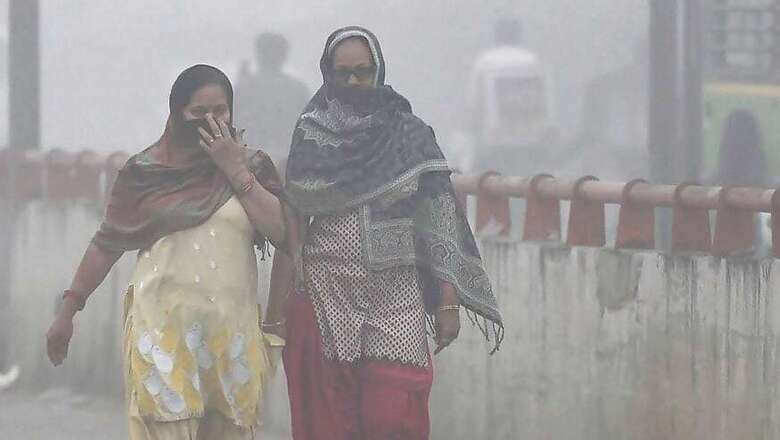
views
While the recent World Health Organisation (WHO) report and its findings on air pollution in India are a cause of worry for the people living in the country, the pollution levels in India and its possible effects on people have already become public knowledge. Yet, hardly any measures have been taken to tackle the problem.
In 2015, a study led by the Indian Institute of Technology-Bombay (IIT-B), the Health Effects Institute (HEI), an advocacy, and the Institute for Health Metrics and Evaluation (IHME), a research institute had stated that only one in 1000 Indians lived in areas where particulate pollution did not exceed the WHO safe levels for fine, toxic dust particles called PM 2.5, according to a new study.
The study, ‘Burden of Disease Attributable to Major Air Pollution Sources in India’, had found that the population in 21 Indian states and six union territories were exposed to PM 2.5 levels above the Indian annual standards or safe levels.
Three years later, the WHO has raised the same concerns. It has said in its report that the Indian capital, Delhi, along with other nine Indian cities has once again been found to be one of the world’s most polluted cities.
Other Indian cities that registered very high levels of PM2.5 pollutants were Kanpur, Faridabad, Gaya, Patna, Lucknow, Agra, Muzaffarpur, Srinagar, Gurgaon, Jaipur, Patiala and Jodhpur.
North India Has The Worse Air, But Why?
Delhi, Agra and Kanpur are known to have very high levels of air pollution and their mention in the WHO report has not come as a shock. But places like Varanasi, Muzaffarpur, Gaya, and Srinagar do not have a high concentration of polluting industries, or other common sources of pollution, such as vehicular emissions. Yet, high levels of PM 2.5 have been recorded in these places.
The main reason for this is that Gangetic plains and valleys are fast emerging as one of major hotspots for air pollution in North India. According to different reports, the air pollutant particles in valleys – trapped between the Himalayas – are unable to disperse very far.
For example Srinagar. The city has been ranked 13th on the list of most polluted cities in the world.
According to a 2015 study, jointly conducted by a team of scientists from Pune-based Indian Institute of Tropical Meteorology (IITM) and University of Kashmir, the air quality in the city deteriorates significantly during the winters in the Srinagar city.
Srinagar is a lush green city, covered in mountains. So how can a city like Srinagar have such high pollution levels?
Though the Valley lacks large-scale industrial development, the region still suffers from air pollution due to automobile emissions, dust thrown up from pot-holed roads, and from the firewood, coal and charcoal that Kashmiris burn to keep themselves warm in the winter. All of this gets trapped in the atmosphere, unable to disperse, given the bowl like shape made by the Himalayan mountains.
According to the same report, the westerly winds originating from Afghanistan and surrounding areas contribute heavily to the high PM2.5 levels in Srinagar.
The city outskirt also has big cement manufacturing plants and brick kilns, which also contribute to the bad air quality in the Srinagar city.
But what makes the air in Gaya and Muzaffarpur so polluted?
The reason again, according to different studies, is the wind redirection.
Once the pollutants enter the Gangetic region, they get trapped, and remain suspended over the area. Most of the particles found in the air of Gaya and Muzaffarpur, therefore, aren’t even generated in these cities itself. An IIT report from 2015 found that more than 55% of the particulate matter found in Muzaffarpur was generated elsewhere.
Delhi’s Air Has Been Worse For Years
Much before the WHO report, which brought the grim reality of Indian cities in terms of air pollution to the fore, many studies had stated how bad Delhi’s air has been.
The study titled, ‘18-Year Ambient PM2.5 Exposure and Night Trends in India Cities’, had earlier found that the PM2.5 levels in Delhi have remained twice the safe standards over the past two decades. The study, conducted by TERI and IIT Delhi, shows that the annual PM2.5 level in Delhi has been 97.4ug/m3 between 1998 and 2005, much higher than permissible limit of 40ug/m3 prescribed by the National Ambient Air Quality Standards.
The study further states that the situation in NCR towns has been no better, with Noida (103.4ug/m3) and Ghaziabad (101ug/m3) being the most polluted.
Indoor Air No Better Than The Outside
The WHO, in its report, also called upon member-countries in its Southeast Asia region to aggressively address the double burden of household and ambient (outdoor) air pollution, saying the region, which comprises India, accounts for 34% or 2.4 million of the seven million premature deaths caused by household and ambient air pollution together globally every year.
Of the 3.8 million deaths caused by household air pollution globally, the region accounts for 1.5 million or 40% deaths, and of the 4.2 million global deaths due to ambient air pollution, 1.3 million or 30% are reported from the region, it said.
Earlier, a report published in Lancet, a noted medical journal, had said that indoor air pollution caused 1.24 lakh premature deaths in India in 2015, more than the emissions from coal power plants or other industrial sources.
The findings in the Lancet report had established what the WHO report has also now confirmed; that the air quality in Indian households, especially in the rural areas, is lethal due to use of wood or cow dung as cooking fuel coupled with poor ventilation.




















Comments
0 comment